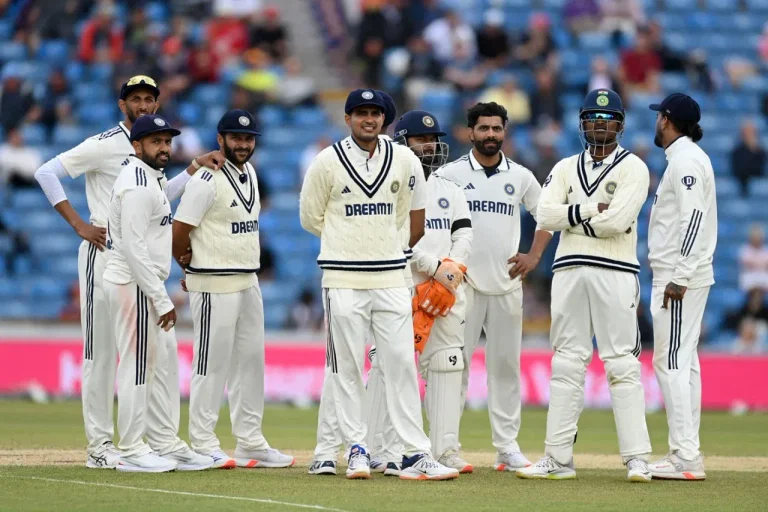
The first Test between India and England at Headingley has once again exposed India’s perennial Achilles’ heel – the fragility of their lower-order batting. Despite brilliant centuries from KL Rahul and Rishabh Pant that seemed to put India in a commanding position, familiar demons returned to haunt the visitors as they suffered a dramatic tail-end collapse that has kept England firmly in the contest.
The Collapse: Numbers Don’t Lie
India’s batting woes at Headingley were stark and devastating. Where India had lost their last five wickets for 24 in their first innings, the pattern repeated itself with alarming consistency in the second innings. The collapse, which saw India all out for 364, gave the dangerous England batting lineup a target of 371 runs, turning what should have been a commanding position into a nail-biting finish.
The numbers paint a grim picture of India’s lower-order frailties. The wickets of Ravindra Jadeja, Jasprit Bumrah, Prasidh Krishna, and Mohammed Siraj fell in quick succession, derailing their progress towards what looked like a potential score of over 500 runs. This represented a swing of momentum that completely changed the complexion of the match.
Josh Tongue: The Tail-Ender’s Nemesis
England’s Josh Tongue emerged as the architect of India’s downfall, particularly when it came to cleaning up the tail. Josh Tongue, just as he did in the first innings, came to the fore when seeing off the Indian tail, with three wickets in four balls helping ensure the tourists lost their final six second-innings wickets for 31 runs. Tongue was the main reason for their hasty conclusion, wrapping up a triple-wicket maiden with the scalps of Shardul Thakur, Mohammed Siraj and Jasprit Bumrah.
Tongue’s ability to exploit India’s lower-order weaknesses in both innings highlights a tactical vulnerability that has plagued Indian cricket for years. His precision and ability to find the right length against tailenders transformed England’s position from one of near-defeat to genuine hope.
A Recurring Pattern of Failure
This collapse at Headingley is not an isolated incident but part of a troubling pattern that has defined India’s Test cricket in recent years. India dropped 6 catches, lost 7 wickets for 41 with the bat and bowlers struggled to support Bumrah in the IND vs ENG 1st Test. The combination of batting fragility and fielding lapses under pressure has become a recurring theme.
The psychological impact of such collapses cannot be understated. When a team is well-positioned with set batsmen at the crease, the expectation is to capitalize and build substantial leads. Instead, India’s inability to add crucial runs through their lower order has repeatedly cost them advantageous positions in Test matches.
Technical and Mental Deficiencies
The root causes of India’s tail-end problems are multifaceted, involving both technical and mental aspects. The lower-order batsmen often lack the basic defensive techniques required to survive in challenging conditions. When facing quality fast bowling with the new ball, or experienced bowlers who know how to exploit their weaknesses, India’s tailenders frequently succumb to deliveries they should be capable of handling.
Mental resilience is equally important. The pressure of performing in crucial situations, combined with the expectation to support the team’s cause, often leads to poor shot selection and hasty dismissals. The rapid succession of wickets in both innings at Headingley suggests a contagious effect where the fall of one wicket creates panic among the remaining batsmen.
Strategic Implications for India
Under Shubman Gill’s captaincy, India needs to address these fundamental issues urgently. The team’s bowling attack, led superbly by Jasprit Bumrah who claimed crucial wickets, cannot consistently bail out the batting unit from precarious positions. The balance of the team becomes severely compromised when 30-40 runs that should be routine contributions from the lower order are consistently missing.
India’s approach to lower-order batting needs systematic overhaul. This includes better preparation in domestic cricket, specialized coaching for tailenders, and perhaps most importantly, changing the mindset from mere survival to meaningful contribution. The difference between adding 30-40 runs and collapsing for minimal scores often determines match outcomes in Test cricket.
Lessons from the Opposition
England’s approach to their lower order provides a stark contrast. Their tailenders, while not spectacular, often contribute valuable runs that prove decisive in tight contests. The ability of players like Chris Woakes and other English lower-order batsmen to frustrate opposition bowlers and add crucial partnerships demonstrates what India is missing.
The tactical awareness and game situation understanding that England’s lower order displays is something India must emulate. Instead of trying to hit their way out of trouble, successful lower-order batsmen focus on occupying the crease, frustrating bowlers, and slowly building partnerships.
The Road Ahead
With four more Tests remaining in the series, India must quickly address these issues. The batting collapse at Headingley has handed England momentum and belief that they can chase down substantial targets. For India to compete effectively in English conditions, they need contributions from every position in the batting order.
The management team must work intensively with the lower-order batsmen on basic defensive techniques, shot selection, and mental preparation. Practice sessions should include specific scenarios where tailenders are required to bat with responsibility and purpose rather than merely trying to survive.
Conclusion
India’s tail-end collapse at Headingley represents more than just poor batting on a given day – it reflects systemic issues that have plagued Indian cricket for years. While the brilliance of Pant and Rahul deserves recognition, their efforts were ultimately undermined by the familiar failings of the lower order.
As this series progresses, India’s ability to rectify these issues will largely determine their success in England. The talented batting lineup cannot consistently carry the burden alone, and until the tail learns to wag meaningfully, India will continue to find themselves in situations where victory slips away despite being in commanding positions.
The Headingley Test serves as another reminder that in the unforgiving arena of Test cricket, every run matters, and every batsman – regardless of their primary skill – must be prepared to contribute when the team needs them most.






